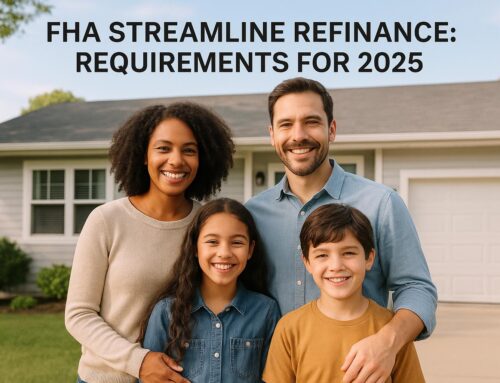Buying a home with today’s high mortgage rates? Here’s how to make it work:
- Set a Budget: Use mortgage calculators to find your maximum home price. Stick to the 28/36 rule (housing costs ≤ 28% of income, total debts ≤ 36%).
- Understand Rates: Higher rates mean higher monthly payments. For example, a $1,000,000 loan at 7% costs $5,996/month – $1,800 more than at 3%.
- Explore Loan Options: Compare fixed-rate mortgages (stable payments) and adjustable-rate mortgages (lower initial rates but potential future increases). Consider government-backed loans like FHA, VA, or USDA for lower upfront costs.
- Negotiate Costs: Use strategies like rate buydowns (pay upfront to lower interest rates) or seller concessions (ask sellers to cover closing costs).
- Get Preapproved: Strengthen your offer by getting preapproved, not just prequalified. This shows sellers you’re serious.
- Boost Credit & Lower Debt: Higher credit scores and lower debt-to-income ratios (DTI) improve loan terms. Pay down debts and avoid new ones before applying.
Quick Tip: Shop around for lenders, compare offers, and use tools like digital mortgage platforms. Combine strategies to save money and make homeownership affordable – even in a challenging market.
2025 Home Buying Tips How to Beat High Interest Rates
Calculate Your Home Buying Budget
If you’re planning to buy a home, the first step is figuring out how much you can afford. With today’s higher mortgage rates, understanding your budget is more important than ever.
Find Your Maximum Home Price
Start by calculating your maximum home price using mortgage calculators. These tools take into account your income, current debts, down payment, and local property taxes to provide a realistic estimate of what you can afford.
For example, NerdWallet‘s calculator uses a 36% debt-to-income (DTI) ratio as a guideline for affordability [3]. The commonly used 28/36 rule suggests keeping your housing costs under 28% of your gross monthly income and total debts under 36%.
When using these calculators, adjust for property taxes and insurance based on your local market. For instance, a $400,000 home in Texas may come with much higher property taxes than a similar home in Florida.
"Know what monthly payment could work for you before you start talking to lenders. This will help you keep things rooted in reality, especially if you know you’ve got hefty monthly expenses that aren’t debts – think stuff like daycare." – NerdWallet [3]
Once you have a better idea of your price range, factor in how rising interest rates might impact your buying power.
How High Interest Rates Affect Your Budget
Interest rates play a huge role in determining how much home you can afford. Mortgage rates have climbed from 2.65% in January 2021 to 7.79% in October 2023 [1].
To see the difference, consider this: a $1,000,000 mortgage at a 3% interest rate would cost about $4,216 per month for principal and interest. At 6%, that same loan would jump to $5,996 per month – an increase of nearly $1,800 every month [4].
Back in 2019, a household earning $69,000 annually could buy a median-priced home and spend about 26% of their monthly income on mortgage payments. Today, that same household would need to allocate roughly 36% of their income [1].
Check Your Debt-to-Income (DTI) Ratio
Lenders rely heavily on your DTI ratio to assess your ability to repay a loan. In fact, a high DTI was the top reason for mortgage application denials in 2022 [5][6].
To calculate your DTI, divide your total monthly debt by your gross income. Include expenses like:
- Mortgage or rent
- Car payments
- Student loans
- Minimum credit card payments
- Personal loans, child support, and alimony [6]
Exclude costs such as utilities, groceries, and entertainment [6].
A DTI of 35% or less is considered manageable [7]. Most lenders won’t approve loans for applicants with a DTI above 50%, and some may set the limit at 36% [7]. For context, the average DTI for recently closed mortgages was 40% [5].
Lenders evaluate two types of DTI:
- Front-end DTI: Your future mortgage payment divided by your gross income.
- Back-end DTI: All monthly debt payments, including your mortgage.
The back-end ratio tends to carry more weight in lending decisions [5].
If your DTI is too high, focus on paying down debt or increasing your income before applying for a mortgage [8]. Look for areas in your budget where you can free up extra funds to reduce debt, and avoid making large purchases that could add to your financial obligations [9].
Review Your Mortgage Loan Options
Once you’ve nailed down your budget, the next step is to dive into the world of mortgage products. In a high-rate market, picking the right loan can make a big difference in managing costs and keeping your home purchase within reach.
Fixed-Rate vs. Adjustable-Rate Mortgages (ARMs)
Fixed-rate mortgages lock in your interest rate for the entire loan term, giving you stable and predictable monthly payments. This consistency not only makes budgeting easier but also shields you from rising rates. If you’re planning to stay in your home for the long haul, this option might be your best bet [10][11].
On the other hand, adjustable-rate mortgages (ARMs) start with lower initial rates that can adjust later based on market conditions [10]. In a high-rate market, this lower starting rate can be appealing. ARMs typically come with an initial fixed-rate period – like three, five, seven, or ten years – before the rate adjusts every six months. The adjustments are tied to benchmarks like the Secured Overnight Financing Rate (SOFR) plus a margin [13][10][12]. To protect borrowers, ARMs include caps that limit how much the rate can increase [10][12].
| Loan Type | Pros | Cons |
|---|---|---|
| Fixed-Rate | Predictable payments; Protection from rising rates | Higher initial rates; Refinancing needed to benefit from rate drops |
| ARM | Lower initial rates; Potential savings if rates drop | Unpredictable payments; Risk of rising rates; More complex terms |
If you think interest rates might drop in the future, an ARM could be worth considering. Just make sure you can handle the payments if rates hit the maximum allowed under the loan terms [10].
Beyond these traditional choices, there are government-backed loans that might offer even more affordability.
Government-Backed Loan Programs
Government-backed loans can make homeownership more accessible, especially in a high-rate environment. They often come with lower upfront costs and more flexible qualification requirements.
- FHA Loans: Backed by the Federal Housing Administration, these loans allow down payments as low as 3.5% for credit scores of 580 or higher. Borrowers with credit scores between 500 and 579 may still qualify with a 10% down payment. FHA loans require an upfront mortgage insurance premium of 1.75% of the loan amount and annual premiums ranging from 0.45% to 1.05% [14][18].
- VA Loans: Designed for veterans, active-duty military, and eligible spouses, VA loans require no down payment and eliminate private mortgage insurance (PMI) [18].
- USDA Loans: Aimed at rural and some suburban areas, USDA loans offer 0% down payments for eligible borrowers. About 97% of the U.S. is geographically eligible. Income limits, usually set at 115% of the area’s median income, apply. As of June 1, 2025, USDA direct loans carry a 4.875% interest rate. These loans also include a 1% upfront guarantee fee and an annual fee of 0.35%, paid monthly [14][15][16].
"First-time homebuyers don’t fit into one box. They have different situations, so having several mortgage options is valuable. It helps borrowers achieve their homebuying goals faster."
- Christian Rodriguez, Tampa, Fla.-based branch administrator, New American Funding [17]
Loan Products for Specific Borrower Types
For those with unique financial situations, there are specialized loan products that cater to specific needs:
- Self-Employed Borrowers: Traditional income verification can be tricky for self-employed individuals. Non-QM (Non-Qualified Mortgage) loans offer more flexible documentation options, like using bank statements or other alternative methods to verify income.
- Real Estate Investors: DSCR (Debt Service Coverage Ratio) loans qualify borrowers based on a property’s rental income rather than personal income, making it easier for investors to grow their portfolios – even in a high-rate market [19].
- First-Time Homebuyers: Many programs are tailored to first-time buyers, offering perks like 0% down payments, grants up to $15,000, and fast closings in as little as 15 days. Some programs also provide closing cost grants up to $7,500 and Community Loans with a 3% down payment and no PMI [20].
- Borrowers with Non-Traditional Credit: Lenders may consider alternative credit sources like timely rent or utility payments. Some programs even offer temporary payment benefits, such as a 1% interest rate credit for the first year [20].
Other niche products might require as little as 1% down, waive PMI, and include closing cost rebates up to $10,000 [20].
The most important step? Compare offers from multiple lenders. Look beyond just the interest rate – consider fees, loan terms, and any special programs that align with your financial goals [19].
Use Rate Buydowns and Seller Concessions
Once you’ve explored mortgage options, there are additional strategies to help reduce costs. Two popular methods – rate buydowns and seller concessions – can significantly cut expenses and save you thousands.
How Rate Buydowns Work
A rate buydown involves paying an upfront fee to lower your mortgage rate, effectively prepaying some of the interest to reduce monthly payments. There are two main types: temporary buydowns and permanent buydowns.
Temporary buydowns lower your rate for a specific period before it resets to the original rate. These are often funded by sellers, homebuilders, or lenders as incentives. Common structures include 2-1 and 3-2-1 buydowns.
Here’s an example from Rocket Mortgage in August 2024, based on a $300,000 loan at a 7% rate:
- 2-1 Buydown:
- Year 1: 5% rate, $1,610.46 monthly payment (saving $4,625.40 annually)
- Year 2: 6% rate, $1,798.65 monthly payment (saving $2,367.12 annually)
- Years 3–30: 7% rate, $1,995.91 monthly payment
- 3-2-1 Buydown:
- Year 1: 4% rate, $1,432.25 monthly payment (saving $6,763.92 annually)
- Year 2: 5% rate, $1,610.46 monthly payment (saving $4,625.40 annually)
- Year 3: 6% rate, $1,798.65 monthly payment (saving $2,367.12 annually)
- Years 4–30: 7% rate, $1,995.91 monthly payment
A 3-2-1 buydown in this scenario would cost about $13,756.
Permanent buydowns, on the other hand, involve purchasing discount points to lower your rate for the entire loan term. Typically, one point costs 1% of the loan amount and reduces the interest rate by roughly 0.25%. For example, on a $300,000 loan, one point would cost $3,000 and might lower the rate from 7% to 6.75%. To decide if this option is worth it, calculate the breakeven point by dividing the cost of the points by the monthly savings. If you plan to stay in the home beyond the breakeven period, this could be a smart move.
"What you get with one point from one lender could be worlds different than with another." – Jennifer Beeston, Senior Vice President, Guaranteed Rate [21]
It’s worth noting that not all lenders offer buydowns, and terms can vary widely. For instance, Rocket Mortgage provides discount points for 30-year fixed, jumbo, VA, and FHA loans, while Bank of America offers points for 15-year, 20-year, and 30-year fixed loans, as well as ARMs. Bank of America also has its America’s Home Grant® program, which may provide up to $7,500 to help qualified borrowers permanently buy down their rates.
Ask for Seller Concessions
Seller concessions are another way to reduce upfront costs by having the seller cover part of your expenses. These concessions are typically used to offset closing costs, which usually range from 2% to 5% of the home’s price. For example, on a $400,000 home, closing costs could be $8,000 to $20,000 – an amount seller concessions can help cover.
"Seller concessions are usually communicated in the offer letter and most commonly accepted when buyers have more control of the market." – Zillow [22]
Timing and market conditions play a big role in negotiating concessions. You’re more likely to succeed in a buyer’s market or when a property has been on the market for a while. For instance, in May 2025, 61% of new construction homes included incentives like reduced mortgage rates, showing that sellers and builders are often willing to negotiate when the market favors buyers.
Seller concessions can be used to cover various costs, including closing fees, moving expenses, repairs, or even credits toward a rate buydown. A March 2023 report from Redfin revealed that 45.5% of sellers offered concessions during the three months ending February 28, compared to 31.1% the previous year [23].
Your real estate agent can help craft an offer that secures concessions without upsetting the seller. Be sure to document everything in writing, and be prepared to compromise or walk away if necessary.
Rate Buydowns vs. Seller Concessions Comparison
When deciding between these two strategies, consider your financial goals and timeline. Here’s a quick comparison:
| Feature | Rate Buydown | Seller Concessions |
|---|---|---|
| Primary Benefit | Lower interest rate and monthly payments | Reduces upfront expenses |
| Cost | Upfront payment for discount points | Seller covers agreed-upon costs |
| Savings | Long-term interest savings or short-term payment reduction | Immediate cash savings at closing |
| Best For | Buyers focused on long-term affordability | Buyers needing upfront financial relief |
| Key Considerations | Breakeven point and refinancing potential | Limits on seller contributions |
For example, a comparison of a $25,000 price reduction versus seller-paid discount points showed buyers saving $67 on their monthly payment and nearly $45,000 in interest over the life of the loan with the discount points [24].
"You’re placing a bet that rates aren’t going to fall dramatically." – Taylor Marr, Deputy Chief Economist at Redfin [24]
If you think interest rates may drop in the near future, negotiating a lower purchase price and planning to refinance later might be a better strategy than paying for a permanent buydown.
Both rate buydowns and seller concessions can be effective tools in a high-rate market. Which option works best depends on your financial situation, market conditions, and long-term plans. You might even explore combining these strategies to maximize your savings.
sbb-itb-8115fc4
Get Prequalified and Improve Your Application
The next step in your homebuying journey is to strengthen your position as a buyer. Building on your budgeting efforts, this phase is all about demonstrating your reliability to sellers. Getting prequalified – or better yet, preapproved – shows you mean business and gives you a clear understanding of what you can afford, even in today’s high-interest environment.
Why Prequalification Matters
Prequalification is a quick and simple way to estimate your borrowing potential. By providing basic financial details, you can get an idea of your budget without affecting your credit score, as it only requires a soft credit check. It’s a great first step before you dive into house hunting.
Preapproval, however, takes things up a notch. This process involves a detailed review of your finances, including verification of your income, assets, and debts. While it does require a hard credit check, it carries much more weight with sellers, signaling that you’re a serious contender.
"A pre-approved buyer is more likely to win an offer over a less prepared buyer or realtor. The more information and detail that can be confirmed in advance, the smoother the process will be once an offer is accepted and processing begins. I would recommend a full pre-approval process whenever it’s possible and time allows." – Phil Crescenzo Jr., Southeast division president of Nation One Mortgage Corporation [25]
In fact, 85% of sellers prefer working with buyers who are preapproved [26]. In a competitive market, this could be the difference between securing your dream home or losing out to someone else.
| Prequalification | Preapproval | |
|---|---|---|
| Benefits | Gives you a general idea of your borrowing power | Positions you as a serious buyer, ready to make offers |
| Process | Quick and based on basic financial info | Involves submitting documents and takes up to 10 business days |
| Documentation | Minimal requirements | Requires proof of income, assets, and debts |
Start with prequalification to get a ballpark figure, then move to preapproval when you’re ready to make offers. While neither guarantees final loan approval, they both strengthen your position and help you move forward with confidence. Once you know your borrowing limits, gather the necessary documents to streamline the preapproval process.
Prepare Your Application Documents
Being organized can speed up the preapproval process and show that you’re ready to move forward. Here’s what to have on hand:
- Personal identification: A government-issued photo ID (like a driver’s license or passport) and your Social Security card [27].
- Income verification: Recent pay stubs and W-2 forms from the past two years. If self-employed, include tax returns, business filings, and a year-to-date Profit and Loss statement [27].
- Asset documentation: Bank statements for checking and savings accounts, along with records for investments like 401(k)s, IRAs, and mutual funds [27].
- Debt information: A detailed list of monthly obligations, including rent, car loans, student loans, credit cards, and current mortgage payments if applicable [27].
Having these documents ready can help you get a preapproval decision within 10 business days.
Strengthen Your Credit and Manage Debt
Once your paperwork is in order, focus on improving your financial profile. Your credit score and debt-to-income ratio (DTI) are key factors in determining your mortgage terms. For example, borrowers with credit scores between 760 and 850 could save up to $116,354 in interest over the life of a $300,000 30-year fixed-rate mortgage compared to those with scores between 620 and 639 [28].
Here are some tips to boost your credit:
- Pay all bills on time. Even one late payment can significantly impact your score [31].
- Reduce credit card balances to below 30% of your available credit [31].
- Check your credit reports for errors and dispute any inaccuracies promptly.
- Avoid closing old credit accounts or opening new ones unnecessarily, as these actions can affect your credit history and utilization ratios [28].
Your DTI is just as important. In 2022, a high DTI was the most common reason for mortgage denials [5]. Aim for a front-end DTI (housing-related expenses) below 28% and a back-end DTI (total debts) under 36%. While conventional loans may allow ratios up to 43–45%, some FHA loans go as high as 50% [29].
To lower your DTI:
- Pay down existing debts, especially those with high interest rates.
- Consider increasing your income through overtime, a side job, or a new position.
- Look at less expensive homes or refinance current debts to lower monthly payments [30].
Lastly, avoid taking on new debt before applying for your mortgage. Even small changes to your financial situation between preapproval and closing can impact your loan terms. A strong credit profile not only improves your mortgage options but also reinforces the trust you’ve built through preapproval.
Use Technology and Professional Help
Tackling a high-rate mortgage market might feel daunting, but combining the right digital tools with expert guidance can make the process smoother. By using technology and tapping into professional expertise, you can uncover competitive rates and make well-informed decisions.
Use Digital Mortgage Platforms
Digital mortgage platforms are reshaping how loans are processed. These tools use automation and AI to cut administrative costs, which can translate into more competitive interest rates [33]. Fintech companies, with their lower overhead and advanced risk assessments, can offer personalized rates tailored to your financial profile [33].
Take HomeLoanAgents, for example. They use cutting-edge technology to speed up approvals through advanced underwriting and digital verification. Their platform enables completely paperless eClosings while providing real-time updates, ensuring transparency throughout the process. These platforms also allow you to compare rates, track market trends, and time your application strategically [33]. Interestingly, as of October 2023, only 7% of mortgage lenders were using Generative AI, highlighting the edge tech-savvy lenders like HomeLoanAgents can provide [32]. Blending these digital tools with professional advice offers a comprehensive approach to navigating today’s market.
Work with Mortgage Professionals
While technology simplifies the loan process, experienced mortgage professionals bring insights that no algorithm can replicate. A skilled professional can help you explore different loan options and tailor recommendations to fit your financial situation. When selecting a mortgage expert, prioritize those who offer a variety of loan products, explain the process clearly, and provide full transparency about costs [36].
Key traits to look for include responsiveness, reliability, and a willingness to guide you through your options [37]. Working with a mortgage broker can be particularly helpful, as they can compare offers from multiple lenders to find competitive rates [34]. Remember, you’re under no obligation to commit to a specific loan, so take the time to shop around for the best terms [37].
Work with Compliant Lenders
In a tightly regulated mortgage landscape, partnering with compliant lenders is crucial. Compliance ensures that lenders follow legal requirements, protecting you from excessive fees or unfair practices [38]. Licensed lenders who adhere to regulations not only safeguard your interests but also help maintain a stable and trustworthy market [39]. On the other hand, non-compliant lenders risk fines or legal issues, which could jeopardize your transaction [38].
To verify a lender’s compliance, check their licensing in your state and review their ratings with organizations like the Better Business Bureau [35]. HomeLoanAgents, for instance, strictly adheres to state and federal regulations, offering a secure and transparent loan process. Choosing a compliant lender not only minimizes legal risks but also ensures a smoother and more reliable mortgage experience.
Conclusion: Your First Steps to Homeownership
Buying a home in today’s high-rate market requires smart planning and thoughtful decisions. Here’s a quick recap: take a close look at your finances, explore different loan options, and use tools like rate buydowns and seller concessions to make the process more manageable.
Start with your finances. Take stock of your savings, income, and any debts. A larger down payment can help lower your interest costs significantly. Once you have a clear picture of your financial situation, focus on improving your credit profile to secure better loan terms.
Boost your credit score. Simple steps like reducing debt and consistently making on-time payments can make a big difference. According to research, 73% of borrowers can raise their credit score by 20 points in just 30 days with credit optimization tools [41].
Get preapproved early. Preapproval not only strengthens your buying power but also helps you understand your budget. Fred Bolstad, Head of Retail Home Lending at U.S. Bank, explains:
"Having pre-approval in hand will be advantageous. And if there are actions you need to take to become buyer-ready, a mortgage loan officer can help develop a plan" [40].
Shop around for lenders. Comparing mortgage rates across multiple lenders is essential. Explore all your options, including government-backed loans, adjustable-rate mortgages (ARMs), and rate buydowns. Don’t forget about seller concessions – they can help cut down your upfront costs, which is especially helpful in today’s market.
Thomas Bullins, sales manager at AmeriSave, adds:
"I think people should buy now. We expect the market to change and rates to go down this year. But we’re also expecting most markets to appreciate and continue to get more expensive" [2].
FAQs
What’s the best way to choose a mortgage in today’s high-interest rate market?
To navigate a high-interest rate market and find the right mortgage, start by assessing your financial situation and long-term goals. One option to consider is an adjustable-rate mortgage (ARM), which typically offers a lower initial rate that could increase over time. For those who qualify, government-backed loans like FHA loans or VA loans may provide more flexible terms and benefits.
You could also look into rate buydowns or seller concessions, which can reduce your interest rate temporarily or even permanently. Shopping around is key – get quotes from multiple lenders to compare interest rates, fees, and other costs. Taking the time to explore these options can help you secure a mortgage that aligns with your budget and financial objectives.
How can I negotiate better terms when buying a home in a high-interest rate market?
Negotiating Better Terms in a High-Interest Rate Market
Navigating a high-interest rate market calls for a smart strategy. Begin by understanding the current market conditions. If it’s a buyer’s market – where the number of homes for sale outpaces the number of buyers – you might have a stronger position to negotiate on price or other terms.
Another approach is to ask for seller concessions. This could mean requesting the seller to cover part of your closing costs or offering credits for repairs flagged during the inspection. You might also negotiate for additional perks, such as including appliances, furniture, or even adjusting the move-in date to better suit your needs.
Partnering with a seasoned real estate agent can also work to your advantage. They’ll have their finger on the pulse of local trends and can guide you in crafting an offer that’s competitive but reasonable. With the right moves, you can strike a deal that fits your financial plans.
How can improving my credit score help me get better mortgage rates and save money?
Improving your credit score isn’t just about numbers – it can lead to better mortgage rates and substantial savings. Lenders tend to offer lower interest rates to borrowers with higher scores, which can significantly reduce monthly payments and save you thousands over the life of a loan. For example, borrowers with credit scores over 740 often qualify for the most competitive rates available.
Beyond saving money, a strong credit score can improve your chances of loan approval and even open the door to more flexible terms, such as reduced down payments. Simple steps like paying your bills on time, cutting down on debt, and reviewing your credit report for mistakes can make a big difference, especially in a high-interest rate environment.
Related posts







